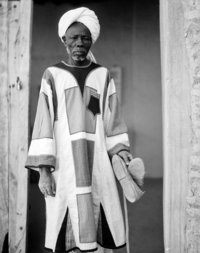Djibba
| Djibba | |
|---|---|

|
|
| Information | |
| Weapon type: | armor |
| Designations: | Djibba, Jibbah |
| Use: | Protective weapon |
| Region of origin / author: |
Africa |
| Distribution: | entire Muslim world |
| Lists on the subject | |
The Djibba , also Jibbah ( Arabic جبة, DMG ǧubba ), is a garment from Africa and was the typical costume of the followers of Mahdi Muhammad Ahmad .
description
The jibba is made of heavy, quilted cotton . This type of armor ( Arabic القطن, DMG al-quṭn 'cotton') is widespread in the Muslim world. The armor is worn alone or is used as body protection under chain armor , where it balances out heat and protects the skin from the friction of the chain fabric. The cotton from which they are made is called (Arabic) dammur . The production of this substance used to be strictly separated according to gender. The yarn was of women spun and men woven . Often a complex pattern of horizontal and vertical lines is incorporated. The slotted lower part makes it possible to wear the jibbah on foot, but also when riding. In the Middle Ages it was used all over the Muslim world, Africa and Europe.
In the Mahdi uprising
In the course of the Mahdi uprising (Arabic Mahdiya , 1881 to 1899), the Mahdi stipulated that his followers should wear uniform clothing. He wanted to take action against the lack of seriousness in the practice of Islam and the spread of the penchant for luxury . The jibba consisted of a knee-length white shirt, ankle-length trousers and a turban . Holes have been mended with symmetrical, black, blue, red, brown, or green patches. This led to the fact that a regular uniform was created up to the Battle of Omdurman and, above all, the captains of the Mahdi decorated themselves with colorful patches. The colored patches were later replaced by colored prints.
The Djibba shown in the individual records was captured by a fallen Mahdi follower ( Ansar ), a Sufi warrior, after the Battle of Omdurman (September 2, 1898). A bullet hole can still be seen on the chest.
literature
- Westphal, Wilfried: Storm over the Nile: the Mahdi uprising, from the beginnings of Islamic fundamentalism . Sigmaringen 1998, ISBN 3-89340-025-7
- Donald F. Featherstone, Khartoum 1885: General Gordon's last stand . (= Osprey military campaign series; Vol. 23), Osprey Publishing, London 1993, ISBN 1-85532-301-X
- Donald Feathertone: Omdurman 1898. Kitchener's victory in the Sudan . (= Osprey military campaign series; Vol. 29). Osprey, London 1994, ISBN 1-85532-368-0
Web links
Individual evidence
- ↑ Pitt Rivers Museum: '' Jibbah from Sudan '' (object: "Jibbah (1919.29.7)")) ( Memento from October 22, 2015 in the Internet Archive ), (English, accessed on October 12, 2012)
